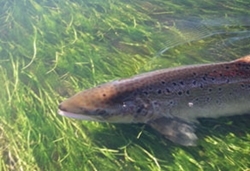 Since the installation of the main river PIT tag detection system, monitoring of downstream moving juveniles is continuous. This has facilitated the observation and first quantification of a significant autumn downstream migration of parr.
Since the installation of the main river PIT tag detection system, monitoring of downstream moving juveniles is continuous. This has facilitated the observation and first quantification of a significant autumn downstream migration of parr.
Although the partial migration and autumnal habitat shifts in salmonids are well documented, the scale of this movement (about 25% of the number of the smolts that migrate in the “usual” spring-time migration) was surprising.
The reasons why some individuals select these life history tactics are little understood and, working with Cefas, we have looked at the state of adaptation to salt water of these fish and where they migrate to. Our studies show that these fish do not migrate out to sea as they are not able to withstand a sea water environment, but they reside over winter in the lower river downstream of Wareham.
We have recorded the first return of an adult fish that was an autumn migrant and we will continue to examine returns from the adult fish to see if the survival of these early moving fish is better or worse than the fish that migrate in the spring. Records from the PIT tag detection systems will enable a greater understanding of the survival of these fish and their role in the ecology of the salmon.